CBSE Class 7 Maths – MCQ and Online Tests – Unit 3 – Data Handling
Every year CBSE students attend Annual Assessment exams for 6,7,8,9,11th standards. These exams are very competitive to all the students. So our website provides online tests for all the 6,7,8,9,11th standards’ subjects. These tests are also very effective and useful for those who preparing for any competitive exams like Olympiad etc. It can boost their preparation level and confidence level by attempting these chapter wise online tests.
These online tests are based on latest CBSE syllabus. While attempting these, our students can identify their weak lessons and continuously practice those lessons for attaining high marks. It also helps to revise the NCERT textbooks thoroughly
CBSE Class 7 Maths – MCQ and Online Tests – Unit 3 – Data Handling
The number of tourists visiting a historical place in a week is shown in the following table :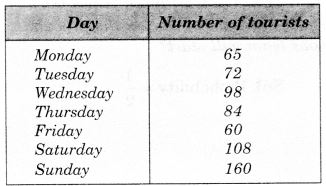
Answer the following related questions.
Question 1.
The difference between the maximum and minimum number of tourists is
(a) 50
(b) 80
(c) 90
(d) 100
Answer
Answer: (d) 100
Hint:
160 – 60 = 100.
Question 2.
On which day 60 tourists visit?
(a) Monday
(b) Tuesday
(c) Friday
(d) Sunday
Answer
Answer: (c) Friday
Hint:
60 ? Friday.
Question 3.
What is the difference between the number of tourists visiting on Friday and Monday?
(a) 10
(b) 24
(c) 38
(d) 5
Answer
Answer: (d) 5
Hint:
65 – 60 = 5.
Question 4.
The sum of the number of tourists visiting on Sunday and Friday is
(a) 160
(b) 60
(c) 220
(d) 100
Answer
Answer: (c) 220
Hint:
160 + 60 = 220.
Question 5.
On which day is the number of tourists maximum?
(a) Sunday
(b) Wednesday
(c) Tuesday
(d) Saturday
Answer
Answer: (a) Sunday
Hint:
Sunday ? 160.
Question 6.
A batsman scored the following number of runs in six innings:
35, 30, 45, 65, 39, 20
The mean runs scored by him in an inning is
(a) 39
(b) 38
(c) 37
(d) 40
Answer
Answer: (a) 39
Hint:
Mean = \(\frac { 35+30+45+65+39+20 }{ 6 } \)
= \(\frac { 234 }{ 6 } \) = 39
Question 7.
The mean of the numbers 10,20, 30 and 40 is
(a) 20
(b) 25
(c) 30
(d) 50
Answer
Answer: (b) 25
Hint:
Mean = \(\frac { 10+20+30+40 }{ 4 } \) = \(\frac { 100 }{ 4 } \) = 25.
Question 8.
The range of the weights (in kg) of a students of a class given below is:
49, 60, 47, 50, 47, 59, 58, 45, 53
(a) 10
(b) 15
(c) 20
(d) 2
Answer
Answer: (b) 15
Hint:
Range = 60 – 45 = 15.
Question 9.
The marks of 11 students of a class are as given below:
78, 11, 99, 63, 94, 6, 78, 36, 30, 55, 22
The range of marks is
(a) 90
(b) 91
(c) 92
(d) 93
Answer
Answer: (d) 93
Hint:
Range = 99 – 6 = 93.
Question 10.
On which day is the number of tourists minimum?
(a) Friday
(b) Monday
(c) Thursday
(d) Saturday
Answer
Answer: (a) Friday
Hint:
Friday ? 60.
Question 11.
The rainfall (in mm) in a city on 7 days of a certain week was recorded as follows: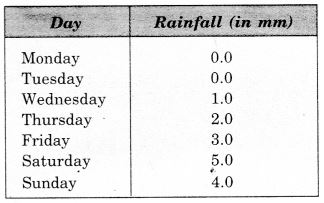
On how many days was the rainfall less than 6 mm?
(a) 0
(b) 3
(c) 6
(d) 7
Answer
Answer: (d) 7
Hint:
On each day,rainfall < 6 mm.
Question 12.
Which of the following statements is true?
(a) The mode is always one of the numbers in a data
(b) The mean is always one of the numbers in a data
(c) Mean < Mode in a data
(d) Median < Mode in a data
Answer
Answer: (a) The mode is always one of the numbers in a data
Question 13.
The marks of some students are as given below:
30, 31, 32, 32, 33, 32, 34, 35, 30, 31, 33, 32
Find the mode of their marks.
(a) 30
(b) 31
(c) 32
(d) 33
Answer
Answer: (c) 32
Hint:
32 occurs maximum number (4) times.
Question 14.
The median of the distribution 2, 3, 4, 7, 5, 1, 6 is
(a) 1
(b) 2
(c) 3
(d) 4
Answer
Answer: (d) 4
Hint:
1, 2, 3, 4, 5, 6, 7.
Question 15.
The median of the data 20, 30, 40, 10, 15, 25, 35 is
(a) 20
(b) 25
(c) 30
(d) 40
Answer
Answer: (b) 25
Hint:
10, 15, 20, 25, 30, 35, 40.
Question 16.
The mode of the distribution 3,5, 7, 4, 2, 1, 4, 3, 4 is
(a) 7
(b) 4
(c) 3
(d) 1
Answer
Answer: (b) 4
Hint:
4 occurs maximum number (3) times.
Question 17.
A die is thrown. What is the probability of getting 6?
(a) 0
(b) \(\frac { 1 }{ 6 } \)
(c) \(\frac { 1 }{ 2 } \)
(d) 1
Answer
Answer: (b) \(\frac { 1 }{ 6 } \)
Hint:
A die has six faces.
Question 18.
A coin is tossed. What is the probability of getting head?
(a) 0
(b) 1
(c) \(\frac { 1 }{ 2 } \)
(d) 2
Answer
Answer: (c) \(\frac { 1 }{ 2 } \)
Hint:
A coin has two faces.
Question 19.
A die is thrown. What is the probability of getting 1?
(a) 0
(b) 1
(c) \(\frac { 1 }{ 2 } \)
(d) \(\frac { 1 }{ 6 } \)
Answer
Answer: (d) \(\frac { 1 }{ 6 } \)
Hint:
A die has six faces.
Question 20.
A coin is tossed. What is the probability of getting tail?
(a) 1
(b) \(\frac { 1 }{ 2 } \)
(c) 2
(d) 0
Answer
Answer: (b) \(\frac { 1 }{ 2 } \)
Hint:
A coin has two faces.
Read the following bar graph and answer the following related questions :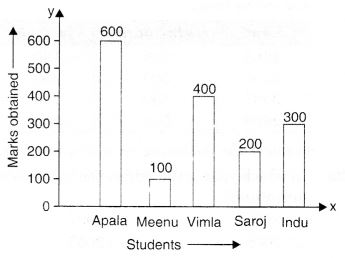
Question 21.
Who has got 400 marks?
(a) Vimla
(b) Saroj
(c) Indu
(d) Apala
Answer
Answer: (a) vimla
Hint:
400 ? Vimla.
Question 22.
Who got the minimum marks?
(a) Apala
(b) Meenu
(c) Vimla
(d) Indu
Answer
Answer: (b) Meenu
Hint:
Meenu ? 100.
Question 23.
The difference between maximum and minimum marks is
(a) 100
(d) 200
(c) 400
(d) 500
Answer
Answer: (d) 500
Hint:
600 – 100 = 500.
Question 24.
The ratio between the marks obtained by Saroj and Vimla is
(a) 1 : 2
(b) 2 : 3
(c) 3 : 4
(d) 1 : 6
Answer
Answer: (a) 1 : 2
Hint:
200 : 400 = 1 : 2.
Question 25.
How many girls have got marks more than 100?
(a) 2
(b) 3
(c) 4
(d) 1
Answer
Answer: (c) 4
Hint:
200, 300, 400, 500 ? 4.
Question 26.
Who got the maximum marks?
(a) Apala
(b) Meenu
(c) Saroj
(d) Indu
Answer
Answer: (a) Apala
Hint:
Apala ? 600.
Question 27.
The difference between the marks obtained by Vimla and Saroj is how many times the difference between the marks obtained by Meenu and Saroj?
(a) 2
(b) 3
(c) 4
(d) 6
Answer
Answer: (a) 2
Hint:
400 – 200 = 200; 200 – 100 = 100; 200 = 2 x 100.
Question 28.
How many girls have got marks less than 600?
(a) 1
(b) 2
(c) 3
(d) 4
Answer
Answer: (d) 4
Hint:
100, 200, 300, 400 ? 4.
Sale of Mathematics and English books in the year 2005, 2006, 2007 and 2008 are given below :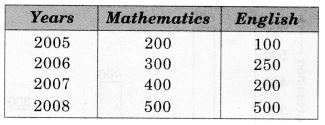
Answer the following related questions :
Question 29.
The rise in the sale of Mathematics books from 2005 to 2008 is
(a) 100
(b) 200
(c) 300
(d) 400
Answer
Answer: (c) 300
Hint:
500 – 200 = 300.
Question 30.
In which year is the difference in the sale maximum?
(a)2005
(b) 2006
(c) 2007
(d) 2008
Answer
Answer: (c) 2007
Hint:
400 – 200 = 200.
Question 31.
The ratio of sales in the year 2005 is
(a) 2 : 1
(b) 3 : 1
(c) 4 : 1
(d) 2 : 3
Answer
Answer: (a) 2 : 1
Hint:
200 : 100 = 2 : 1.
Question 32.
In which year is the difference in the sale minimum?
(a) 2008
(b) 2007
(c) 2006
(d) 2005
Answer
Answer: (a) 2008
Hint:
2008 ? 500 – 500 = 0.
Question 33.
The fall in the sale of English books from 2006 to 2007 is
(a) 50
(b) 100
(c) 150
(d) 200
Answer
Answer: (a) 50
Hint:
250 – 200 = 50.
Number of children in six different classes are given below :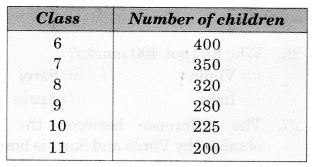
Answer the following related questions.
Question 34.
In how many classes is the number of children more than 100?
(a) 6
(b) 4
(c) 3
(d) 1
Answer
Answer: (a) 6
Hint:
In each class, number of students > 100.
Question 35.
In which class is the number of children minimum?
(a) 8
(b) 9
(c) 10
(d) 11
Answer
Answer: (d) 11
Hint:
11 ? 200.
Question 36.
The difference between the maximum and minimum number of children is
(a) 100
(b) 200
(c) 300
(d) 400
Answer
Answer: (b) 200
Hint:
400 – 200 = 200.
Question 37.
In how many classes is the number of children less than 500?
(a) 2
(b) 4
(c) 5
(d) 6
Answer
Answer: (d) 6
Hint:
In each class, number of students < 500.
Question 38.
The ratio of the number of children of class 6 and 11 is
(a) 3 : 1
(b) 2 : 1
(c) 2 : 3
(d) 1 : 4
Answer
Answer: (b) 2 : 1
Hint:
400 : 200 = 2 : 1.
Question 39.
The total number of children is
(a) 1775
(b) 1675
(c) 1575
(d) 1785
Answer
Answer: (a) 1775
Hint:
400 + 350 + 320 + 280 + 225 + 200 = 1775.
Question 40.
In which class is the number of children maximum?
(a) 6
(b) 7
(c) 8
(d) 9
Answer
Answer: (a) 6
Hint:
6 ? 400.














0 Comments:
Post a Comment